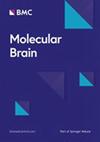Chronic pain enhances excitability of corticotropin-releasing factor-expressing neurons in the oval part of the bed nucleus of the stria terminalis
IF 3.3
3区 医学
Q2 NEUROSCIENCES
引用次数: 0
Abstract
We previously reported that enhanced corticotropin-releasing factor (CRF) signaling in the bed nucleus of the stria terminalis (BNST) caused the aversive responses during acute pain and suppressed the brain reward system during chronic pain. However, it remains to be examined whether chronic pain alters the excitability of CRF neurons in the BNST. In this study we investigated the chronic pain-induced changes in excitability of CRF-expressing neurons in the oval part of the BNST (ovBNSTCRF neurons) by whole-cell patch-clamp electrophysiology. CRF-Cre; Ai14 mice were used to visualize CRF neurons by tdTomato. Electrophysiological recordings from brain slices prepared from a mouse model of neuropathic pain revealed that rheobase and firing threshold were significantly decreased in the chronic pain group compared with the sham-operated control group. Firing rate of the chronic pain group was higher than that of the control group. These data indicate that chronic pain elevated neuronal excitability of ovBNSTCRF neurons.慢性疼痛会增强纹状体末端床核卵圆形部分的促肾上腺皮质激素释放因子表达神经元的兴奋性
我们曾报道,纹状体末端床核(BNST)中促肾上腺皮质激素释放因子(CRF)信号的增强会导致急性疼痛时的厌恶反应,并抑制慢性疼痛时的大脑奖赏系统。然而,慢性疼痛是否会改变BNST中CRF神经元的兴奋性仍有待研究。在这项研究中,我们通过全细胞膜片钳电生理学方法研究了慢性疼痛诱导的 BNST 卵圆部 CRF 表达神经元(ovBNSTCRF 神经元)兴奋性的变化。CRF-Cre; Ai14小鼠通过tdTomato来观察CRF神经元。通过对神经病理性疼痛模型小鼠脑片的电生理记录发现,与假手术对照组相比,慢性疼痛组的流变基数和发射阈值明显降低。慢性疼痛组的发射率高于对照组。这些数据表明,慢性疼痛会提高ovBNSTCRF神经元的兴奋性。
本文章由计算机程序翻译,如有差异,请以英文原文为准。
求助全文
约1分钟内获得全文
求助全文
来源期刊

Molecular Brain
NEUROSCIENCES-
CiteScore
7.30
自引率
0.00%
发文量
97
审稿时长
>12 weeks
期刊介绍:
Molecular Brain is an open access, peer-reviewed journal that considers manuscripts on all aspects of studies on the nervous system at the molecular, cellular, and systems level providing a forum for scientists to communicate their findings.
Molecular brain research is a rapidly expanding research field in which integrative approaches at the genetic, molecular, cellular and synaptic levels yield key information about the physiological and pathological brain. These studies involve the use of a wide range of modern techniques in molecular biology, genomics, proteomics, imaging and electrophysiology.
 求助内容:
求助内容: 应助结果提醒方式:
应助结果提醒方式:


